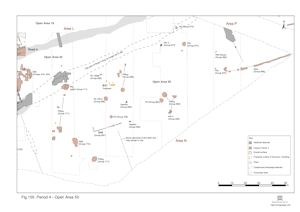
While OA28 remains intact through the mid-Roman period, the remainder of the Southern Zone enclosures evidently do not. Although the precise time in Period 4 is uncertain, OAs 24-27 are disrupted by a new and non-conforming boundary ditch and are therefore presumably replaced by a new system of landscape division but one that is still probably restricted to south of Road 3 (Figure 155).
This new enclosure system is termed OA50 (although technically it separates this part of the Southern Zone into two entities).
The physical remains of the OA50 imposition are described below. The subsequent use of this part of the Southern Zone is described here.

Ditch 25177 (segs 8692, 8696, 19157) is a 1m-wide, 0.6m-deep cut and clearly a major feature that extends from its terminal in the middle of Excavation Area P eastwards for at least 50m. Its roughly east-west alignment takes it across the south part of OAs 25 and 24 and their shared boundary. The finds assemblages from the single ditch fill are limited to pottery - mortarium sherds provide a date of late 2nd to early 3rd century - and relatively large quantities of tile. The western terminal of the ditch is later marked by pit 19136 (Group 675 Period 5), which is the only feature to demonstrably post-date this ditch.
Structure 48 (gully 25087, segs 24145, 24391, 24403, 24391, 24403, 24434) straddles the OA26 and OA27 boundary and lies in both land units. It may mark the disuse of the major enclosure boundary but seems to be poorly defined and the dating is variable. It comprises a very insubstantial, discontinuous gully/ditch line, only some 0.48m wide at most and no more than 0.22m deep, running ENE-WSW. Pre-excavation plans trace it quite clearly for at least 21m, and suggest a right-angled turn to the north at its western end, but this is not explored.
Structure 48 may be a beam-slot but is unlikely to form part of a building. It may represent a fenceline, but is noticeably not orthogonal with the earlier fence line (Period 3) to its east or to Road/track 3, and no other excavated features can be linked with it to form a more extensive boundary system. Finds are rather sparse and very mixed in date. That from segment 24391 may be late 3rd century or later, and there is also box flue tile in 24403.
Its presence implies a new subdivision of that part of the lower terrace south of Road/track 3, although with so few other features in this vicinity, any functional differences remain invisible.
The relationship between Structure 48 and cut 25081 (Group 146 Period 2B) as recorded is uncertain, and some data imply that 25081 was the later. This is clearly at odds with the available dating evidence, but it should be borne in mind that 25081 is a later re-cut within the main Group 146 enclosure ditch 25082 and itself contains late dating evidence.
Although previously described as a Period 3 feature located on top of the boundary between OAs 24 and 25, big 'pit' 25221 is mentioned here because it continues to accumulate material into the 3rd century. Interpreted to perpetuate at least part of the boundary between OAs 24 and 25, it is likely that its boundary function ends with the imposition of OA50. However, being such a substantial hole, it is entirely possible that material simply continues to accumulate within its top.
Internet Archaeology is an open access journal based in the Department of Archaeology, University of York. Except where otherwise noted, content from this work may be used under the terms of the Creative Commons Attribution 3.0 (CC BY) Unported licence, which permits unrestricted use, distribution, and reproduction in any medium, provided that attribution to the author(s), the title of the work, the Internet Archaeology journal and the relevant URL/DOI are given.
Terms and Conditions | Legal Statements | Privacy Policy | Cookies Policy | Citing Internet Archaeology
Internet Archaeology content is preserved for the long term with the Archaeology Data Service. Help sustain and support open access publication by donating to our Open Access Archaeology Fund.